For ornithologists studying birds by adding colour-rings, flags and tracking devices, a question of fundamental importance is always “am I affecting the birds’ survival or behaviour by requiring them to carry these markers?” This is not just a welfare issue; if marking birds affects the way that birds behave or changes their chance of survival then any findings are dubious. In a paper in Journal of Field Ornithology, Emily Weiser explores whether leg flags influence the nesting success of four species of small wader (shorebird).
Using leg-flags
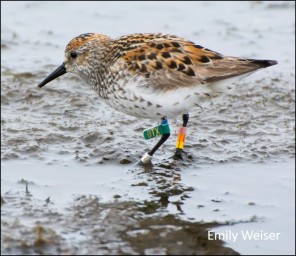
Western Sandpiper
Rings rarely have any negative effects on birds and are frequently used to mark individuals. Leg flags are bigger and easier to see, and there is space to add letters/numbers, but they are also bulkier and heavier. Might there be a consequence of flag-wearing for the nesting success or survival of individuals? By analysing nesting-success data collected at seven sites in Arctic Alaska and western Canada, Emily Weiser and colleagues were able to check for flag effects on four species of Arctic-breeding shorebird: Semipalmated and Western Sandpipers and Red-necked and Grey (Red) Phalaropes. The study involved measuring daily survival rates for nearly 2000 nests – which is a huge sample size. The amount of work involved is reflected in the fact that the Weiser paper has 24 authors!
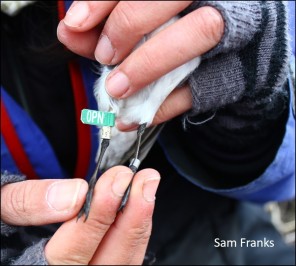 A flag is a plastic strip shaped to wrap around a bird’s leg. It is like a colour-ring but with a tab that extends from the leg, increasing its conspicuousness and providing an opportunity to inscribe a letter/number code. The probability of generating individual sightings can be increased but at what costs? Might flags make nesting birds more obvious to predators? Could the bulkier flag damage the eggs? Might the flag affect incubation efficiency? Whilst it was not possible to answer each of these questions separately, the total effect could be measured by checking to see if nest survival was different for birds wearing flags, as opposed to rings.
A flag is a plastic strip shaped to wrap around a bird’s leg. It is like a colour-ring but with a tab that extends from the leg, increasing its conspicuousness and providing an opportunity to inscribe a letter/number code. The probability of generating individual sightings can be increased but at what costs? Might flags make nesting birds more obvious to predators? Could the bulkier flag damage the eggs? Might the flag affect incubation efficiency? Whilst it was not possible to answer each of these questions separately, the total effect could be measured by checking to see if nest survival was different for birds wearing flags, as opposed to rings.
Findings
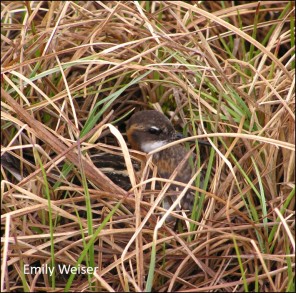
Male Red-necked Phalarope
Between 205 and 780 nests of the four species of Arctic-breeding shorebirds were included in the study, with between 36% and 82% of these nests having at least one adult with a leg flag in attendance. For the two sandpipers (Western and Semipalmated), the sample included nests with two flagged parents, about half as many where only one parent had a flag and others where parents wore colour-rings (bands), rather than flags. Female phalaropes do not brood their eggs so, for Red-necked and Grey (Red) Phalaropes, nests were categorised by whether males wore flags, or just colour-rings. Several different analyses were carried out, to take account of the number of flagged parents, year effects etc., as you can read in the paper, but there is one key result; there is no evidence that leg flags affect the daily survival rate (DSR) of the nests for any of the four species, or the probability that a nest is successful (see figure).
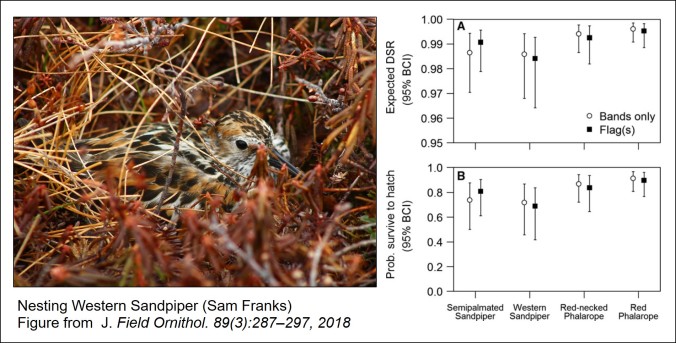
Across the whole incubation period, the proportion of nests expected to hatch did not differ between nests with or without flagged adults. There was variation between species, with the estimated probability of eggs hatching varying from 70% for Western Sandpiper to 91% for Grey (Red) Phalarope. These figures are higher than reported previously because the analysis was only for nests where at least one bird was captured. Early failures were therefore excluded. Overall nest success rates are reported in this paper.
A mix of species
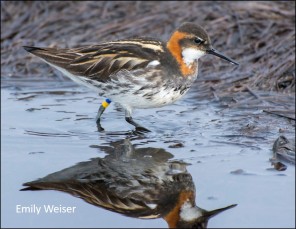
Colour-ringed Red-necked Phalarope
This study focused on four small species of wader, from Semipalmated Sandpiper (26g) to Grey (Red) Phalarope (49g), in which any effects of (relatively large) flags on breeding success might be expected to be higher than for larger species of wader. The results are very similar, despite the fact that sandpipers and phalaropes differ in two potentially important ways:
- The species behave very differently, using very different feeding methods – phalaropes feed mainly on water, while the two sandpipers feed on land and at the land-water interface
- In sandpipers, both parents attend the nest but in phalaropes only one parent (the male) attends the nest.
Could flags have other effects?
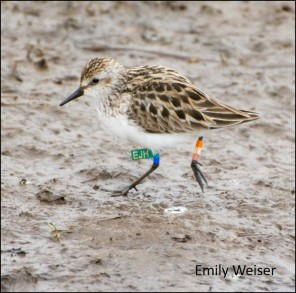
Flagged Semipalmated Sandpiper
Nothing in the data analysed for this paper suggests that flags are affecting survival rates of marked birds during the period when birds are breeding. The authors suggest that it would be useful to undertake further analyses to check:
- Nest survival rates for a broader range of species and in different habitats (where, for instance, predators might behave differently).
- Growth rates of chicks wearing flags and of chicks being cared for by parents wearing flags.
- Annual survival rates of adults and chicks that wear flags.
Emily Weiser has also written a review of the effects of leg-mounted geolocators on waders/shorebirds. Here she found that there could be problems in a small number of circumstances. This important paper is summarised in this blog: Are there costs to wearing geolocators?
Another WaderTales blog examines the preening and feeding behaviour of Green Sandpipers that wear geolocators attached to harnesses.
More in the paper
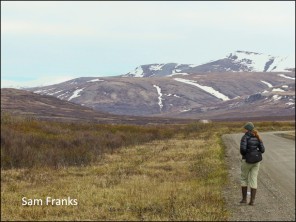
Emily Weiser in the field
Any researchers who wish to investigate the effects of marking birds will find it useful to read the whole paper, for details of methods and analyses. There is also a long list of references relating to the effects of marking birds. Information about the particular types of flags used in these studies may also be helpful.
Effects of leg flags on nest survival of four species of Arctic-breeding shorebirds: Emily L. Weiser, Richard B. Lanctot, Stephen C. Brown, H. River Gates, Rebecca L. Bentzen, Megan L. Boldenow, Jenny A. Cunningham, Andrew Doll, Tyrone F. Donnelly, Willow B. English, Samantha E. Franks, Kirsten Grond, Patrick Herzog, Brooke L. Hill, Steve Kendall, Eunbi Kwon, David B. Lank, Joseph R. Liebezeit, Jennie Rausch, Sarah T. Saalfeld, Audrey R. Taylor, David J. Ward, Paul F. Woodard and Brett K. Sandercock Field Ornithol. 89(3):287–297, 2018 DOI: 10.1111/jofo.12264


Graham (@grahamfappleton) has studied waders for over 40 years and is currently involved in wader research in the UK and in Iceland. He was Director of Communications at The British Trust for Ornithology until 2013 and is now a freelance writer and broadcaster.
I think also its important to factor in the opinion of the wider public (in particular the birders who will report sightings). If the perception is that a marker (such as neck rings or these flags) is too much, then there may be a reluctance to engage with the projects.
LikeLike
Hi Graham I love your blog – lots of information on conservation topics, and an excellent way of accessing the literature second-hand and getting to hear about some of the great research being carried out on waders. Do you do requests? I ask because I am intrigued by sanderlings – how they manage to find enough food to keep them buzzing about with such energy on apparently barren sandy shores. Text books and internet searches only tell me that they feed on small molluscs, crustaceans and worms (sometimes the order varies!) which is far too generic to be helpful. I am guessing they are picking up tiny translucent amphipods from the surface but when I have tried netting along the surface at the edge of the tide I haven’t caught any. A blog post on the diet, energetics and adaptations of sanderlings would be much appreciated. Regards Hugh Watson
LikeLike
Thank you for the kind comments. I have no plans to write about Sanderling but will definitely take an opportunity if a new paper is published that can form the basis of a new blog. Meanwhile, this paper might help: https://s3.amazonaws.com/academia.edu.documents/598082/reneerkens_Sanderling_review_WSG_Bull_2009.pdf?AWSAccessKeyId=AKIAIWOWYYGZ2Y53UL3A&Expires=1541660635&Signature=afl8li8jSlvFIm3Tetz6M5mmkLU%3D&response-content-disposition=inline%3B%20filename%3DSanderlings_using_African_Eurasian_flywa.pdf
LikeLike
Pingback: WaderTales blogs in 2018 | wadertales
Reblogged this on Wolf's Birding and Bonsai Blog.
LikeLike
Pingback: Flagging up potential problems | wadertales
Pingback: Dunlin: tales from the Baltic | wadertales